Characteristics
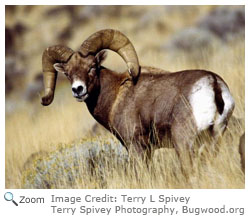 The bighorn sheep has tan or brown fur. It has a white belly, rump, and muzzle. It is best known for its large horns. The ram has large, thick curving horns. The bighorn sheep has tan or brown fur. It has a white belly, rump, and muzzle. It is best known for its large horns. The ram has large, thick curving horns.
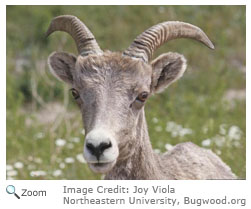 The ewe's horns are more slender and less curved. Males weigh between 125-300 pounds, females weigh between 75-200 pounds. The bighorn is a good climber and jumper. Its hooves are hard around the outside and soft on the inside, which gives the bighorn traction on slippery rocks. The ewe's horns are more slender and less curved. Males weigh between 125-300 pounds, females weigh between 75-200 pounds. The bighorn is a good climber and jumper. Its hooves are hard around the outside and soft on the inside, which gives the bighorn traction on slippery rocks.
Range
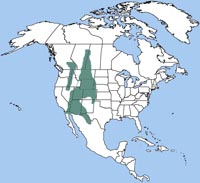 The bighorn sheep is found in the Rocky Mountains from southern Canada to Colorado and parts of Nevada, western Texas, eastern California, and northern Mexico. The bighorn changes its home range seasonally. In warm months, it grazes on mountain slopes; in colder months it moves down to valleys. Female bighorns live in groups of five to fifteen sheep made up of ewes and their young. Males live in groups of two to five sheep. In the winter, bands of ewes may join together and form large groups of up to 100 sheep. Males join the female groups during mating season. The bighorn sheep is found in the Rocky Mountains from southern Canada to Colorado and parts of Nevada, western Texas, eastern California, and northern Mexico. The bighorn changes its home range seasonally. In warm months, it grazes on mountain slopes; in colder months it moves down to valleys. Female bighorns live in groups of five to fifteen sheep made up of ewes and their young. Males live in groups of two to five sheep. In the winter, bands of ewes may join together and form large groups of up to 100 sheep. Males join the female groups during mating season.
Habitat
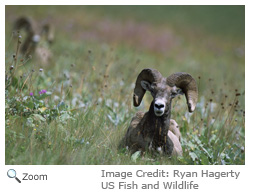 Bighorn sheep live in alpine meadows, mountain slopes, and foothills. They like areas with rocky slopes that they can climb to evade predators. Bighorn sheep live in alpine meadows, mountain slopes, and foothills. They like areas with rocky slopes that they can climb to evade predators.
Diet
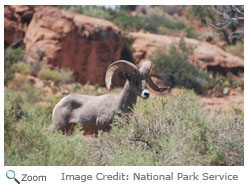 The bighorn sheep browses on grasses, clover, and sedges in warm months. In colder months, it eats woody plants like willow and sage. Bighorn sheep in desert areas often eat brushy plants like holly and cactus. When it is not grazing, it lies down and chews its cud. The bighorn sheep browses on grasses, clover, and sedges in warm months. In colder months, it eats woody plants like willow and sage. Bighorn sheep in desert areas often eat brushy plants like holly and cactus. When it is not grazing, it lies down and chews its cud.
|
|
Life Cycle
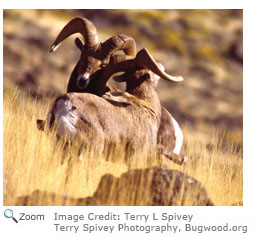 In the fall, males have head butting contests to establish dominance. They run at each other at speeds of up to 20 miles an hour and ram their heads together. A ram usually only fights with another ram who has horns that are about the same size as his horns. Head butting contests can last as long as 20 hours! The dominant ram will mate with more females than the other rams. In the fall, males have head butting contests to establish dominance. They run at each other at speeds of up to 20 miles an hour and ram their heads together. A ram usually only fights with another ram who has horns that are about the same size as his horns. Head butting contests can last as long as 20 hours! The dominant ram will mate with more females than the other rams.
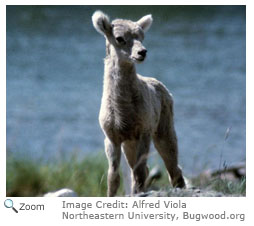 Females have their babies on a cliff that's hard to access. They have one baby. Lambs are woolly and white and have little horns. They can walk and climb by the first day. The lamb stays hidden where it was born for about a week, and then it starts to follow its mother. Females have their babies on a cliff that's hard to access. They have one baby. Lambs are woolly and white and have little horns. They can walk and climb by the first day. The lamb stays hidden where it was born for about a week, and then it starts to follow its mother.
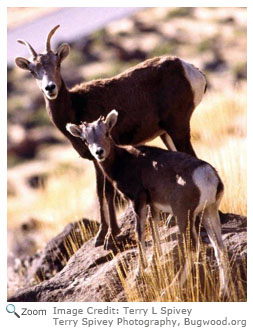 The lamb is weaned when its is about five months old. A male lamb leaves his mother and joins a male group when he is between two and four years old. A female lamb usually remains with her mother's group for her whole life. The lamb is weaned when its is about five months old. A male lamb leaves his mother and joins a male group when he is between two and four years old. A female lamb usually remains with her mother's group for her whole life.
Video Credit: US Fish and Wildlife
|